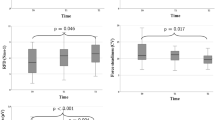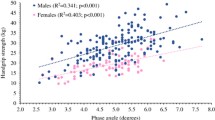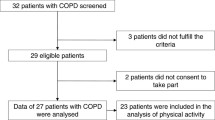Abstract
Skeletal muscle performance and muscle mass are commonly reduced in patients with advanced chronic obstructive pulmonary disease (COPD). It is currently unclear, however, whether negative changes in muscle structure and function are proportionately related to each other in these patients. In a cross-sectional study, 39 patients (post-bronchodilator FEV1 = 49.7 ± 15.5% pred) and 17 controls were submitted to knee isokinetic dynamometry [peak torque (PT), isometric strength (IS), and total work (TW)] and dual energy X-ray absorptiometry for the evaluation of leg muscle mass (LMM). Muscle function (F) was normalised for LMM by using ratio standards (F·LMM−1), power function ratios (F·LMM−b, where b is usually ≠ 1), and analysis of covariance (ANCOVA). Patients with COPD presented with reduced PT, IS, TW, and LMM as compared to controls: there were significant linear correlations among these variables in both groups (P < 0.05). Ratio standards of PT·LMM−1 and TW·LMM−1 were, on average, 14% lower in patients than controls (P < 0.01). The coefficients for allometric correction of IS and TW were significantly higher in patients as compared to controls (0.975 vs. 0.603 and 1.471 vs. 0.824, respectively, P < 0.05), i.e. more LMM was needed to generate a given functional output in patients than normal subjects. In addition, adjusted means of muscle function variables by ANCOVA were 11–18% lower for patients than controls with LMM as the covariate (P < 0.05). We conclude that factors other than simple atrophy (i.e. mass-independent mechanisms) might play a role in explaining the COPD-related skeletal muscle dysfunction.
Similar content being viewed by others
References
Agusti AG, Sauleda J, Miralles C, Gomez C, Togores B, Sala E, Batle S, Busquets X (2001) Skeletal muscle apoptosis and weight loss in chronic obstructive pulmonary disease. Am J Respir Crit Care Med 166:485–489
American Thoracic Society/European Respiratory Society (1999) Skeletal muscle dysfunction in chronic obstructive pulmonary disease. Am J Respir Crit Care Med 159:S1–S40
Bernard S, LeBlanc P, Whittom F, Carrier G, Jobin J, Belleau R, Maltais F (1998) Peripheral muscle weakness in patients with chronic obstructive pulmonary disease. Am J Respir Crit Care Med 158:629–634
Davies MJ, Dalsky GP (1997) Normalizing strength for body size differences in older adults. Med Sci Sports Exerc 29:713–717
Debigaré R, Côté CH, Hould FS, LeBlanc P, Maltais F (2003) In vitro e in vivo contrctile properties of the vastus lateralis muscles in males with COPD. Eur Respir J 21:273–278
Engelen MP, Schols AM, Does JD, Wouters EF (2000a) Skeletal muscle weakness is associated with wasting of extremity fat-free mass but not with airflow obstruction in patients with chronic obstructive pulmonary disease. Am J Clin Nutr 71:733–738
Engelen MP, Schols AM, Does JD, Deutz NE, Woulters EF (2000b) Altered glutamate metabolism is associated with reduced muscle glutathione levels in patients with emphysema. Am J Respir Crit Care Med 161:98–103
Lohman T (1996) Dual energy X-ray absorptiometry. In: Roche AF, Heymsfield SB, Lohman TG. Human body composition. Champaing, III. Human Kinetics Publishers
Mador MJ, Deniz O, Aggarwal A, Kufel TJ (2003) Quadriceps fatigability after single muscle exercise in patients with chronic obstructive pulmonary disease. Am J Respir Crit Care Med 168:102–108
Man WD, Soliman MG, Nikoletou D, Harris ML, Rafferty GF, Mustfa N, Polkey MI, Moxham J (2003) Non-volitional assessment of skeletal muscle strength in patients with chronic obstructive pulmonary disease. Thorax 58:665–669
Marquis K, Debigare R, Lacasse Y, LeBlanc P, Jobin J, Carrier G, Maltais F (2002) Midthigh muscle cross-sectional area is a better predictor of mortality than body mass index in patients with chronic obstructive pulmonary disease. Am J Respir Crit Care Med 166:809–813
National Heart, Lung, Blood Institute/World Health Organization (2001) Global strategy for the diagnosis, management, and prevention of chronic obstructive pulmonary disease. NHLBI/WHO global initiative for chronic obstructive lung disease (GOLD) workshop summary. Am J Respir Crit Care Med 163:1256–1276
Neder JA, Nery LE, Silva AC, Andreoni S, Whipp BJ (1999a) Maximal aerobic power and leg muscle mass and strength related to age in non-athletic males and females. Eur J Appl Physiol 79:522–530
Neder JA, Andreoni S, Castelo-Filho A, Nery LE (1999b) Reference values for lung function tests. I. Static volumes. Braz J Med Biol Res 32:703–717
Neder JA, Andreoni S, Peres C, Nery LE (1999c) Reference values for lung function tests. III. Carbon monoxide diffusing capacity (transfer factor). Braz J Med Biol Res 32:729–737
Neder JA, Nery LE, Shinzato GT, Andrade MS, Peres C, Silva AC (1999d) Reference values for concentric knee isokinetic strength and power in nonathletic men and women from 20 to 80 years old. J Orthop Sports Phys Ther 29:116–126
Nevill A (1997) Why the analysis of performance variables recorded on a ratio scale will invariably benefit from a log transformation. J Sports Sci 15:457–458
Nevill AM, Holder RL (1995) Scaling, normalizing, and per ratio standards: an allometric modelling approach. J Appl Physiol 79:1027–1031
Pereira CBSP, Simões JG, Pereira FWJ (1992) Valores de referência para a espirometria em uma amostra da população brasileira adulta. J Pneumol 18:10–22
Saey D, Michaud A, Couillard A, Maltais F (2005) Contractile fatigue, muscle morphometry, and blood lactate in chronic obstructive pulmonary disease. Am J Respir Crit Care Med 171:1109–1115
Schols AM, Soeters PB, Dingemans AM, Mostert R, Frantzen PJ, Wouters EF (1993) Prevalence and characteristics of nutritional depletion in patients with stable COPD eligible for pulmonary rehabilitation. Am Rev Respir Dis 147:1151–1156
Steiner MC, Singh SJ, Morgan MD (2005) The contribution of peripheral muscle function to shuttle walking performance in patients with chronic obstructive pulmonary disease. J Cardiopulm Rehabil 25:43–49
Toth MJ, Goran MI, Ades PA, Howard DB, Poehlman ET (1993) Examination of data normalization procedures for expressing peak VO2 data. J Appl Physiol 75:2288–2292
Vanderburgh PM, Mahar MT, Chou CH (1995) Allometric scaling of grip strength by body mass in college-age men and women. Res Q Exerc Sport 66:80–84
Welsman JR, Armstrong N, Nevill AM, Winter EM, Kirby BJ (1996) Scaling peak VO2 for differences in body size. Med Sci Sports Exerc 28:259–265
Whittom F, Jobin J, Simard PM, Leblanc P, Simard C, Bernard S, Belleau R, Maltais F (1998) Histochemical and morphological characteristics of the vastus lateralis muscle in patients with chronic obstructive pulmonary disease. Med Sci Sports Exerc 30:1467–1474
Winter EM (1992) Scaling: partitioning out differences in size. Pediatr Exerc Sci 4:296–301
Yoshikawa M, Yoneda T, Takenaka H, Fukuoka A, Okamoto Y, Narita N, Nezu K (2001) Distribution of muscle mass and maximal exercise performance in patients with COPD. Chest 119:93–98
Acknowledgment
Supported by Research Grants from Coordenadoria de Aperfeiçoamento do Pessoal de Nível Superior (CAPES), Conselho Nacional de Desenvolvimento Científico e Tecnológico (CNPq), and Fundação de Amparo à Pesquisa do Estado de São Paulo (FAPESP), Brazil.
Author information
Authors and Affiliations
Corresponding author
Additional information
JA Neder is an established investigator of the CNPq (level II).
Rights and permissions
About this article
Cite this article
Malaguti, C., Nery, L.E., Corso, S.D. et al. Scaling skeletal muscle function to mass in patients with moderate-to-severe COPD. Eur J Appl Physiol 98, 482–488 (2006). https://doi.org/10.1007/s00421-006-0292-8
Accepted:
Published:
Issue Date:
DOI: https://doi.org/10.1007/s00421-006-0292-8




